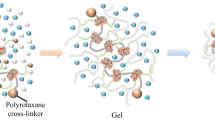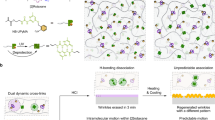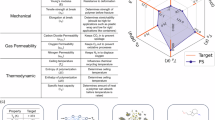Abstract
This review discusses seven synthetic approaches for fabricating topologically crosslinked polymers with rotaxane structures at the crosslinking points (rotaxane-crosslinked polymers, RCPs). RCPs exhibit unique properties such as high swelling capability, high elasticity and stimuli-responsiveness attributed to the rotaxane-crosslinking points. This article primarily focuses on the four most recently developed strategic approaches for synthesizing RCPs in which various rotaxane components, such as crown ethers/ammonium salts, cyclodextrins/hydrophobic guests and metal-coordinated macrocycles/ligands, are employed. Two of these RCP synthetic methods efficiently introduce special structures and functions into the RCP crosslinking points. Using these methods, we inserted well-studied rotaxane systems that exhibit deslipping behavior into the crosslinking points of network polymers. Notably, each of the resulting RCPs exhibited chemostimuli-responsive or photoresponsive degradability due to the deslipping behavior of the rotaxane system incorporated into the RCP. The other two methods are based on the use of rotaxane crosslinkers to fabricate versatile RCPs containing vinyl trunk polymers. The efficiencies and applications of these recently developed methods are compared with those of conventional methods.
Similar content being viewed by others
Log in or create a free account to read this content
Gain free access to this article, as well as selected content from this journal and more on nature.com
or
References
Takata, T., Kihara, N. & Furusho, Y. Polyrotaxanes and polycatenanes: recent advances in syntheses and applications of polymers comprising of interlocked structures. Adv. Polym. Sci. 171, 1–75 (2005).
Huang, F. & Gibson, H. W. Polypseudorotaxanes and polyrotaxanes. Prog. Polym. Sci. 30, 982–1018 (2005).
Harada, A. Supramolecular polymers based on cyclodextrins. J. Polym. Sci. Part A: Polym. Chem. 44, 5113–5119 (2006).
Wenz, G., Han, B.-H. & Mueller, A. Cyclodextrin rotaxanes and polyrotaxanes. Chem. Rev. 106, 782–817 (2006).
Takata, T. Polyrotaxane and polyrotaxane network: supramolecular architectures based on the concept of dynamic covalent bond chemistry. Polym. J. 38, 1–20 (2006).
Mayumi, K. & Ito, K. Structure and dynamics of polyrotaxane and slide-ring materials. Polymer 51, 959–967 (2010).
Takata, T., Arai, T., Kohsaka, Y., Shioya, M. & Koyama, Y. Polyrotaxane network as a topologically cross-linked polymer: synthesis and properties in Supramolecular Polymer Chemistry ed. Harada A., Ch. 15, 331–346 (Wiley-VCH, Weinheim, Germany, 2012).
Delaviz, Y. & Gibson, H. W. Macrocyclic polymers 2. Synthesis of poly(amide crown ethers) based on bis(5-carboxy-1,3-phenylene)-32-crown-10. Network formation through threading. Macromolecules 25, 4859–4862 (1992).
Gong, C. & Gibson, H. W. Supramolecular chemistry with macromolecules. Macromolecular knitting, reversible formation of branched polyrotaxanes by self-assembly. Macromol. Chem. Phys. 199, 1801–1806 (1998).
Gibson, H. W., Nagveker, D. S., Powell, J., Gong, C. & Bryant, W. S. Polyrotaxanes by in situ self threading during polymerization of functional macrocycles. Part 2. Poly(ester crown ether)s. Tetrahedron 53, 15197–15207 (1997).
Gong, C. & Gibson, H. W. Self-Threading-based approach for branched and/or cross-linked poly(methacrylate rotaxane)s. J. Am. Chem. Soc. 119, 5862–5866 (1997).
Gong, C. & Gibson, H. W. Controlling polymeric topology by polymerization conditions: mechanically linked network and branched poly(urethane rotaxane)s with controllable polydispersity. J. Am. Chem. Soc. 119, 8585–8591 (1997).
Gibson, H. W., Nagvekar, D. S., Yamaguchi, N., Bhattarcharjee, S., Wang, H., Vergene, M. & Hercules, D. M. Polyamide pseudorotaxanes, rotaxanes, and catenanes based on bis(5-carboxy-1,3-phenylene)-(3x+2)-crown-x ethers. Macromolecules 37, 7514–7529 (2004).
Zada, A., Avny, Y. & Zilkha, A. Monomers for non-bond crosslinking of vinyl polymers. Eur. Polym. J. 35, 1159–1164 (1999).
Zada, A., Avny, Y. & Zilkha, A. Monomers for non-bond crosslinking of vinyl polymers. II. Cyclic octaethylene glycol 5-methacrylamido-isophthalate. Eur. Polym. J. 36, 351–357 (2000).
Zada, A., Avny, Y. & Zilkha, A. Monomers for non-bond crosslinking of vinyl polymers. III. Some characteristics of the system. Eur. Polym. J. 36, 359–364 (2000).
Zilkha, A. Non-bond crosslinked polymer hydrogels. Eur. Polym. J. 37, 2145–2146 (2001).
Oike, H., Mouri, T. & Tezuka, Y. A cyclic macromonomer designed for a novel polymer network architecture having both covalent and physical linkages. Macromolecules 34, 6229–6234 (2001).
Kubo, M., Hibino, T., Tamaura, M., Uno, T. & Itoh, T. Synthesis and copolymerization of cyclic macromonomer based on cyclic polystyrene: gel formation via chain threading. Macromolecules 35, 5816–5820 (2002).
Kubo, M., Kato, N., Uno, T. & Itoh, T. Preparation of mechanically cross-linked polystyrenes. Macromolecules 37, 2762–2765 (2004).
Kubo, M., Matsuura, T., Morimoto, H., Uno, T. & Itoh, T. Preparation and polymerization of a water-soluble, nonbonding crosslinking agent for a mechanically crosslinked hydrogel. J. Polym. Sci. Part A Polym. Chem. 43, 5032–5040 (2005).
de Gennes, P. G. Sliding gels. Physica A 271, 231–237 (1999).
Okumura, Y. & Ito, K. The polyrotaxane gel: a topological gel by figure-of-eight cross-links. Adv. Mater. 13, 485–487 (2001).
Ito, K. Slide-ring materials using topological supramolecular architecture. Curr. Opin. Solid State Mater. Sci. 14, 28–34 (2010).
Kato, K. & Ito, K. Dynamic transition between rubber and sliding states attributed to slidable cross-links. Soft Matter. 7, 8737–8740 (2011).
Mayumi, K., Tezuka, M., Bando, A. & Ito, K. Mechanics of slide-ring gels: novel entropic elasticity of a topological network formed by ring and string. Soft Matter. 8, 8179–8183 (2012).
Kato, K. & Ito, K. Polymer networks characterized by slidable crosslinks and the asynchronous dynamics of interlocked components. React. Funct. Polym. 73, 405–412 (2013).
Watanabe, J., Ooya, T., Park, K. D., Kim, Y. H. & Yui, N. Preparation of characterization of poly(ethylene glycol) hydrogels cross-linked by hydrolyzable polyrotaxane. J. Biomater. Sci., Polym. Ed. 11, 1333–1346 (2000).
Watanabe, J., Ooya, T., Nitta, K.-H., Park, K. D., Kim, Y. H. & Yui, N. Fibroblast adhesion and proliferation on poly(ethylene glycol) hydrogels crosslinked by hydrolysable polyrotaxane. Biomaterials 23, 4041–4048 (2002).
Ichi, T., Nitta, K., Lee, W. K., Ooya, T. & Yui, N. Preparation of porous hydrolysable polyrotaxane hydrogels and their erosion behavior. J. Biomater. Sci. Polym. Ed. 14, 567–579 (2003).
Ooya, T., Ichi, T., Furubayshi, T., Katoh, M. & Yui, N. Cationic hydrogels of PEG crosslinked by a hydrolysable polyrotaxane for cartilage regeneration. React. Funct. Polym. 67, 1408–1417 (2007).
Harada, A., Li, J. & Kamachi, M. The molecular necklace: a rotaxane containing many threaded α-cyclodextrins. Nature 356, 325–327 (1992).
Harada, A., Li, J. & Kamachi, M. Double-stranded inclusion complexes of cyclodextrin threaded on poly(ethylene glycol). Nature 370, 126–128 (1994).
Kohsaka, Y., Nakazono, K., Koyama, Y. & Takata, T. Size-complementary rotaxane cross-link: effect on stabilization and degradation of supramolecular network. Angew. Chem., Int. Ed. 50, 4872–4875 (2011).
Koyama, Y., Yoshii, T., Kohsaka, Y. & Takata, T. Photo-degradable cross-linked polymer derived from a vinylic rotaxane cross-linker possessing aromatic disulfide axle. Pure Appl. Chem. 85, 835–842 (2013).
Arai, T., Jang, K., Koyama, Y., Asai, S. & Takata, T. Versatile supramolecular cross-linker: a rotaxane cross-linker that directly endows vinyl polymers with movable cross-links. Chem. Eur. J. 19, 5917–5923 (2013).
Ogawa, M., Kawasaki, A., Koyama, Y. & Takata, T. Synthesis and properties of polyrotaxane network prepared from Pd-templated bis-macrocycle as a topological cross-linker. Polym. J. 43, 909–915 (2011).
Ashton, P. R., Baxter, I., Fyfe, M. C. T., Raymo, F. M., Spencer, N., Stoddart., J. F., White, A. J. P. & Williams, D. J. Rotaxane or pseudorotaxane? That is the question!. J. Am. Chem. Soc. 120, 2297–2307 (1998).
Tachibana, Y., Kihara, N., Furusho, Y. & Takata, T. Is the tert-butyl group bulky enough to end-cap a pseudorotaxane with a 24-crown-8-ether wheel? Org. Lett. 6, 4507–4509 (2004).
Makita, Y., Kihara, N. & Takata, T. Quantitative active transport in [2]rotaxane using a one-shot acylation reaction toward the linear molecular motor. J. Org. Chem. 73, 9245–9250 (2008).
Akae, Y., Okamura, H., Koyama, Y., Arai, T. & Takata, T. Selective synthesis of a [3]rotaxane consisting of size-complementary components and its stepwise deslippage. Org. Lett. 14, 2226–2229 (2012).
Nakanozo, K. & Takata, T. Neutralization of a sec-ammonium group unusually stabilized by the “rotaxane effect”: synthesis, structure, and dynamic nature of a ‘free’ sec-amine/crown ether-type rotaxane. Chem. Eur. J. 16, 13783–13794 (2010).
Furusho, Y., Hasegawa, T., Tsuboi, A., Kihara, N. & Takata, T. ‘Unlock-lock’ approach to [2] and [3]rotaxanes: entering of a ring through disulfide linkage that is unlocked by thiol ‘key’. Chem. Lett. 29, 18–19 (2000).
Furusho, Y., Oku, T., Hasegawa, T., Tsuboi, A., Kihara, N. & Takata, T. Dynamic covalent approach to [2]- and [3]rotaxanes by utilizing a reversible thiol-disulfide interchange reaction. Chem. Eur. J. 9, 2895–2903 (2003).
Oku, T., Furusho, Y. & Takata, T. First poly[3]rotaxane synthesized through the noncovalent step-growth polymerization of a homoditopic dumbbell compound and a macrocycle with a reversible thiol–disulfide interchange reaction. J. Polym. Sci. Part A Polym. Chem. 41, 119–123 (2003).
Oku, T., Furusho, Y. & Takata, T. Rotaxane-stabilized thiophosphonium salt from disulfide and phosphine. Org. Lett. 5, 4923–4925 (2003).
Oku, T., Furusho, Y. & Takata, T. A concept for recyclable cross-linked polymers: topologically networked polyrotaxane capable of undergoing reversible assembly and disassembly. Angew. Chem. Int. Ed. 43, 966–968 (2004).
Bilig, T., Oku, T., Furusho, Y., Koyama, Y., Asai, S. & Takata, T. Polyrotaxane networks formed via rotaxanation utilizing dynamic covalent chemistry of disulfide. Macromolecules 41, 8496–8503 (2008).
Yoshii, T., Kohsaka, Y., Moriyama, T., Suzuki, T., Koyama, Y. & Takata, T. An efficient synthetic entry to rotaxanes utilizing reversible cleavage of aromatic disulfide bonds. Supramol. Chem. 22, 1029–0478 (2010).
Furusho, Y., Matsuyama, T., Takata, T., Moriuchi, T. & Hirao, T. Synthesis of novel interlocked systems utilizing a palladium complex with 2,6-pyridinedicarboxamide- based tridentate macrocyclic ligand. Tetrahedron Lett. 45, 9593–9597 (2004).
Miyagawa, N., Watanabe, M., Matsuyama, T., Koyama, Y., Moriuchi, T., Hirao, T., Furusho, Y. & Takata, T. Successive catalytic reactions specific to Pd-based rotaxane complexes as a result of wheel translation along the axle. Chem. Commun. 46, 1920–1922 (2010).
Miyagawa, N., Kawasaki, A., Watanabe, M., Ogawa, M., Koyama, Y. & Takata, T. Synthesis and properties of metal-templated polyrotaxane. Kobunshi Ronbunshu 68, 702–709 (2011).
Iijima, K., Kohsaka, Y., Koyama, Y., Nakazono, K., Uchida, S., Asai, S. & Takata, T. Stimuli-degradable cross-linked polymers synthesized by radical polymerization using a size-complementary [3]rotaxane cross-linker. Polym. J. 46, 67–72 (2013).
Acknowledgements
I thank all my co-workers and collaborators for their great contributions to the studies covered in this review: Professor T Takata as a research supervisor (Tokyo Institute of Technology, Japan), Dr Y Kohsaka (methods 4 and 5), Dr K Nakazono (method 4), Professor S Asai (methods 4 and 6), Mr T Yoshii (method 5), Mr T Moriyama (method 5), Mr T Suzuki (method 5), Dr T Arai (method 6), Dr K Jang (method 6), Mr M Ogawa (method 7), Ms A Kawasaki (method 7) and Mr K Iijima (method 5 and new systems). Moreover, I am grateful for the financial support from JSPS KAKENHI Grant Numbers 22750101, 21106508, 24685023 and 25102510.
Author information
Authors and Affiliations
Corresponding author
Rights and permissions
About this article
Cite this article
Koyama, Y. Synthesis of topologically crosslinked polymers with rotaxane-crosslinking points. Polym J 46, 315–322 (2014). https://doi.org/10.1038/pj.2014.9
Received:
Revised:
Accepted:
Published:
Issue date:
DOI: https://doi.org/10.1038/pj.2014.9
Keywords
This article is cited by
-
Preparation of dual-cross network polymers by the knitting method and evaluation of their mechanical properties
NPG Asia Materials (2022)
-
Material properties and applications of mechanically interlocked polymers
Nature Reviews Materials (2021)
-
Effect of silica nanoparticle size on the mechanical strength and wellbore plugging performance of SPAM/chromium (III) acetate nanocomposite gels
Polymer Journal (2019)
-
Synthesis of rotaxane cross-linked polymers derived from vinyl monomers using a metal-containing supramolecular cross-linker
Polymer Journal (2015)



